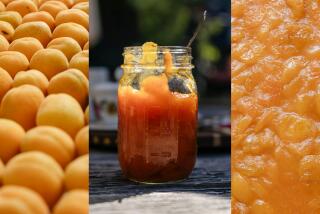The Comeback ‘Cot
- Share via
On an average, Americans eat only three apricots a year. And that’s the good news.
Until very recently, times had not been kind to the apricot industry. Per-capita consumption, which had never been more than two pounds a year, had plummeted. Even now, after three years of steady growth, Americans eat only roughly six-tenths of a pound per year.
“There are still large regions in the United States (that) don’t even know what an apricot is, or they have forgotten,” says Gene Stokes, general manager of the California Apricot Advisory Board, a marketing group. “We now have a new set of generations who are totally ignorant of the product.”
That does seem to be changing, though. Within the past 10 years, there have been substantial gains in the consumption of fresh apricots.
“Fresh, which never was a big part of the apricot industry (accounting for between 5% and 7% of total sales), really began growing at a dynamic rate after 1984,” Stokes says. “It has literally tripled and is about 16% to 18% now. That’s the brightest thing we have to look forward to, this renaissance in fresh fruit. And as we improve varieties, I think we’ll see substantially more growth.”
The secret to the apricot’s recent success seems painfully simple: better-tasting fruit. First, a new variety called the Castlebrite began to show up on the market. The standard fresh apricot, the Royal or Blenheim, was delicious but would not ship well. The Castlebrite, while not as flavorful, was a good-looking apricot that resisted bruising.
“When they found this new variety was such a great shipper, everybody jumped on it,” Stokes says. “They rode on that one for a couple of years just because it looked so good and consumers wanted to buy it, but then the grocery trade began to say ‘Where’s the flavor? These are nice big apricots, but we need something that tastes better.’ ”
And into the breach stepped another variety--the Patterson, which had been grown as a canning apricot for many years. “Now they have a fruit that is pretty universal,” Stokes says. “It can be used for canning, freezing or fresh. So now we’re on another plateau. I think the next growth period will be in fresh, and it will be because of our improving varieties beyond the Castlebrite and beyond the Patterson.”
In fact, Stokes says he thinks apricot consumption may even triple by the year 2000. “With what I see in the industry, I don’t think that’s unrealistic at all. The fresh market is the key. Now we’re seeing quite a few people who used to grow apricots only for canners begin to put their pinkies into the fresh market. That gives them flexibility and opens up whole new resources.”
More to Read
Eat your way across L.A.
Get our weekly Tasting Notes newsletter for reviews, news and more.
You may occasionally receive promotional content from the Los Angeles Times.









